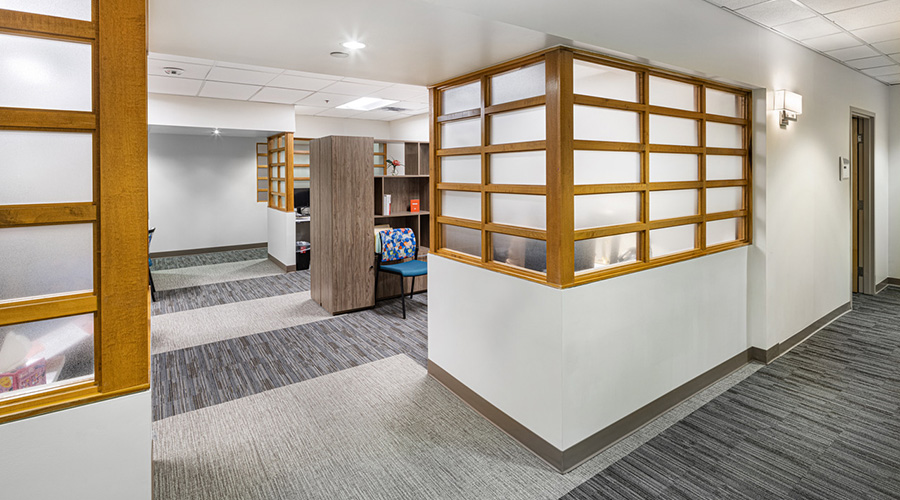In 2024, the healthcare industry will face disruption from new competitors and technologies while also managing the ongoing challenges of rising costs and slimming margins. In the face of these disruptions, leading research from JLL indicates that now is the time for healthcare facilities managers to reevaluate their real estate footprints and staffing.
In order to do more with less, facilities can take advantage of new technologies and artificial intelligence (AI) to make real-time facilities adjustments and improve efficiency. Combined, these actions will help systems improve their market share, increase patient access and satisfaction and reduce costs so they can better compete in the healthcare industry and build a stronger workplace culture.
Transforming real estate to support growth
In the middle of 2023, healthcare companies ranked reducing operating costs as their top priority. Tight margins and a challenging capital environment will continue in 2024, causing health systems and care providers to look to their real estate to reduce costs, unlock cash and improve revenue.
This year, facilities should focus on optimization and cost reduction, and a good place to start is by evolving their real estate departments. This evolution includes reevaluating and revamping their staffing and processes, including instituting value or performance metrics.
It also can include implementing workflow technology and automation to help leaders address daily operations, repairs and improvements across facilities. By adjusting real estate portfolios, optimizing property management and adjusting maintenance, facilities can free up additional dollars for other priorities that create a more human-centric workplace and, ultimately, an enhanced patient-care experience.
Meanwhile, uncertainty over interest rates has affected pricing and yields for new development, making financing more difficult and causing a slowdown in healthcare construction. Facilities tight on cash might want to unlock and redeploy capital trapped in real estate. This process can include pursuing a sale-leaseback to an experienced medical property investor or a straight disposition sale to divest underused assets.
Lastly, revenue growth can be driven further through an elevated location strategy. In the 2023 JLL Healthcare Patient Consumer Survey, location or proximity ranked as the second-highest factor for a patient’s healthcare decision behind “accepts my insurance.” Patients will identify and travel the shortest time possible for primary, urgent and emergency care, and they are willing to travel longer for more specialist care. By strategically placing locations using demographic and consumer analysis, health systems can drive revenue by growing their patient populations.
Using real estate to address workforce gap
Wages for healthcare jobs have risen dramatically in the last few years, outpacing inflation and putting pressure on healthcare systems. At its core, healthcare is people taking care of people, so healthcare systems will have to adjust other areas of their business to accommodate for sustained higher wage growth to enable this mission.
Paired with an increase in the volume of healthcare needs and an increase of facility manager retirements, many systems are bracing for a workforce gap. Unless significant changes are made, the deficit of healthcare workers will only worsen, causing delays in patient care, continued burnout among workers and access implications with delayed openings of new facilities.
A focused real estate strategy is part of the solution. Facilities teams can improve efficiency by understanding the way healthcare workers interact with their spaces through utilization tracking. Burnout can be reduced by providing aesthetically pleasing, safe, high-quality environments, including spaces for rejuvenation during long shifts.
AI to improve care, upgrade facilities
Facility management teams rely on a variety of technologies to meet evolving challenges. But in 2024, they will increasingly use AI to assist with decision making to improve efficiency of daily tasks and overall planning. And they will not be alone, as AI increasingly touches every facet of healthcare delivery.
On the patient care side, AI can act as a partner, freeing up clinicians and administrators to focus on the components of their jobs that only humans can do. AI can bridge the gap between the labor shortage and increasing demand for care by doing more without adding staff.
On the facility side, health systems can apply AI to understand the way a provider’s time is spent to better plan facility use. AI portfolio optimization technologies use ChatGPT to answer the way to best optimize spaces and portfolios. Other AI technologies can improve facilities management efficiency. Some technologies allow for real-time adjustments to HVAC systems, while others use sensors to manage performance, optimize cleanliness and maintenance and monitor energy use and emissions.
In 2024, healthcare facilities can elevate patient and caregiver experiences by strategically optimizing their real estate and using AI to increase efficiency — all while improving safety, comfort and compliance. This change can result in maximized room for innovative patient care, increased retention and uncovering costs savings that can be redirected to where it matters most: impacting people’s lives.
Alison Flynn Gaffney, FACHE, is president of the healthcare division, work dynamics, for JLL.

 Joint Commission Standards: What Updates Matter Most?
Joint Commission Standards: What Updates Matter Most? Swinerton Completes Construction at Atlanta's Grady Hospital
Swinerton Completes Construction at Atlanta's Grady Hospital NY Governor Hochul Announces $300M in Funds for IT and Cybersecurity
NY Governor Hochul Announces $300M in Funds for IT and Cybersecurity Healthcare Is the New Retail
Healthcare Is the New Retail Bridgeway Behavioral Health Services Launches Campaign to Renovate Health Center
Bridgeway Behavioral Health Services Launches Campaign to Renovate Health Center